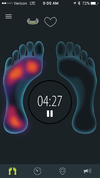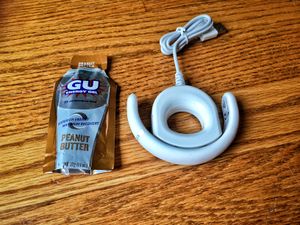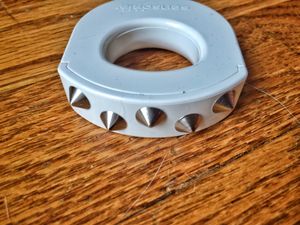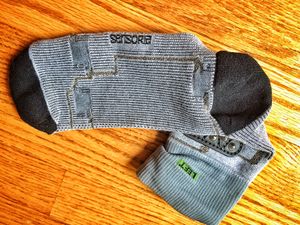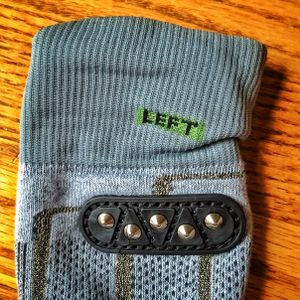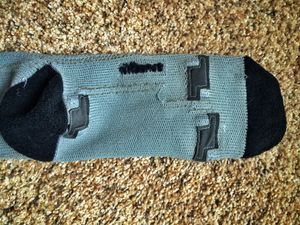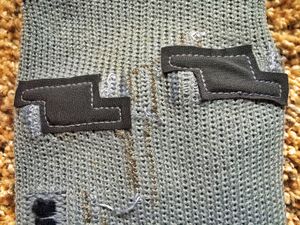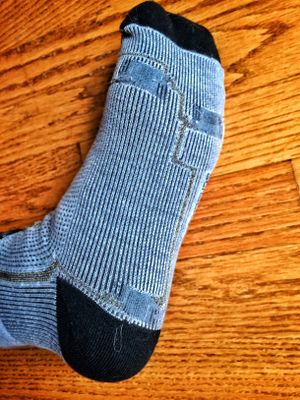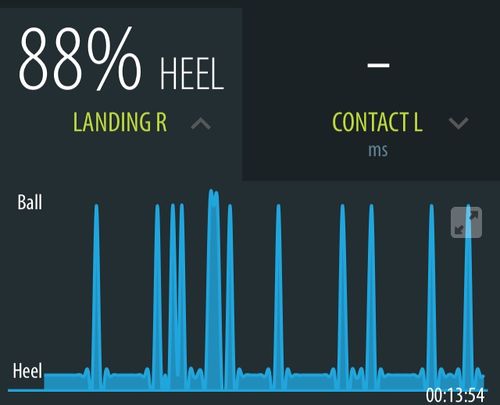Difference between revisions of "Sensoria"
User:Fellrnr (User talk:Fellrnr | contribs) (Created page with "The principle behind Sensoria is a cool one. They've created a stock that has built in pressure sensors underneath, and a small anklet that relays the pressure to a smart phon...") |
(No difference)
|
Revision as of 15:01, 13 July 2016
The principle behind Sensoria is a cool one. They've created a stock that has built in pressure sensors underneath, and a small anklet that relays the pressure to a smart phone. This allows Sensoria to detect Foot Strike patterns with a potentially far more accuracy and an accelerometer-based system. In addition the anklet has accelerometers to measure Ground Contact Time and impact. If the sensors react fast enough, then the system could potentially detect rates of loading to see how hard the runner's landing. It's with these great expectations that I started my testing, performing a number of runs in different footwear and with different Foot Strike patterns, comparing the Sensoria against other Running Sensors, including RunScribe, the Garmin Running Dynamics, MilestonePod, and Moov Now. Sadly, my testing reveals that the system doesn't seem to work in the real world. Let me lay out the liturgy of problems:
- The biggest concern is that the system doesn't work, or at least, not reliably enough to be of any use. When I first put on the socks and anklet, the accompanying app would show in real time how much pressure was on each of the three sensors as a 'heat map' (see screen shot below). If I press my heel to the ground the heel area would light up, and if I press my forefoot to the ground the two forefoot sensors with light up on the app. This was both rather cool, and confirmation the system was working. Sadly, after only a few minutes of running the real-time display showed that the sensor was no longer responding. It's possible that this was due to sweat building up, but after only a few minutes this seems unreasonable. I contacted their support and described the problem, to which they responded with "During a long run the pressure sensor heat map and real-time visualization on your phone may be impacted by different environmental factors. However the real-time feedback algorithms and the web dashboard have been designed to provide you with accurate data." This does not seem reasonable or logical to me, but to give them the benefit of the doubt I did some further testing.
- I tested the Sensoria with three different shoes (heavily cushioned, minimally cushioned, and nearly barefoot), and I tested each shoe with my normal rear foot landing, a forefoot only landing, and a forefoot first landing. My intended Foot Strike pattern was confirmed by RunScribe. You can read about the details of this testing below, but the bottom line is that the Sensoria didn't report my foot strike correctly. I think that this is a showstopper, but I'll continue to list the other issues. (I tested the Sensoria using both the left and the right sock, so I'm reasonably confident that the problem is not an isolated manufacturing issue.)
- The socks that come with the Sensoria are remarkably thick and warm, and I did not want to wear them for any length of time except in winter. They've done a good job in making the sensor pads relatively innocuous, but I found that when I was forefoot running in nearly barefoot shoes the front pads hurt my foot. You have to pay close attention when putting the Sensoria socks on to sure the sensors are in the right place, and I had to verify this each time I changed shoes. The only good news with the thick, heavy socks is that they kept the anklet in place firmly.
- The basic premise of Sensoria seems to be that you should land forefoot and that heel strike is bad. The evidence to support that idea is currently a little limited, but even if you put your target foot strike as heel, the smart phone app will nag you to land on the ball of your foot. Talking of the nagging smart phone app, I found it rather annoying rather than helpful.
- The basic package only gives you one anklet, so you don't get any balance information, but you could buy a second anklet.
- The Sensoria requires you to run with your phone, which I think is a major annoyance. While many folks are happy doing this, I find a smart phone rather cumbersome and I'd much rather have the information displayed on the watch.
- In addition to the broken Foot Strike information, the Sensoria also gives Ground Contact Time and some impact information post-run. The impact is on a scale of 1 to 10, but is not in g's (gravities). The reported Ground Contact Time by Sensoria is quite a bit higher than any of the other systems.
Contents
1 Gallery
2 Test runs
My first test consisted of nine runs; three with Minimax Hoka Cliftons, three with more minimally cushioned Saucony Endorphin, and three with the near barefoot Merrell Vapor Glove. The first of each sequence was with my normal rear Foot Strike, the second was with forefoot only landing without my heel ever making contact with the ground, and the third was forefoot landing with the heel briefly touching down. I compared the Sensoria with the RunScribe and the Garmin Running Dynamics, and in the RunScribe graphs below, yellow is Ground Contact Time and blue is Foot Strike. As you can see from the table below, run scribe is reporting a Foot Strike number that is appropriate for how I was running. However, the Sensoria is reporting that time heel striking even when I'm running on my forefoot.
| Shoe | [[Foot Strike] | Sensoria % Heel | RunScribe Foot Strike | Sensoria Impact | RunScribe Impact (g's) | Sensoria GCT | RunScribe GCT | GRD GCT |
|---|---|---|---|---|---|---|---|---|
| Hoka Clifton | Rear | 99 | 1.8 | 1.98 | 8.9 | 346 | 293 | 243 |
| Hoka Clifton | Fore Only | 66 | 13.0 | 1.44 | 10.8 | 339 | 273 | 247 |
| Hoka Clifton | Fore First | 76 | 10.5 | 1.4 | 9.3 | 368 | 310 | 256 |
| Saucony Endorphin | Rear | 83 | 2.6 | 1.84 | 11.5 | 350 | 284 | 238 |
| Saucony Endorphin | Fore Only | 83 | 14.2 | 1.35 | 9.3 | 338 | 269 | 248 |
| Saucony Endorphin | Fore First | 94 | 13.5 | 1.58 | 10.1 | 341 | 309 | 257 |
| Merrell Vapor Glove | Rear | 98 | 2.6 | 2.03 | 10.7 | 346 | 307 | 236 |
| Merrell Vapor Glove | Fore Only | 100 | 14.1 | 1.17 | 10.5 | 350 | 306 | 249 |
| Merrell Vapor Glove | Fore First | 89 | 14.3 | 1.71 | 11 | 346 | 310 | 246 |
2.1 Rear Strike Hokas
Both systems are clearly reporting that I'm landing on my heel as you can see below. The RunScribe system has a little more nuance, but the Sensoria seems to be doing okay. RunScribe actually rated my foot strike as 1.8 on a scale of 1 to 16, which gives a little more information than simply a percentage of the time heel striking.
2.2 Forefoot Only Hokas
The RunScribe system is correctly reporting a forefoot landing, with a score of 13. You can see from the graph that its Foot Strike index varies a little bit, which is understandable given that an accelerometer-based system can't know if my heel is actually touching the ground on not. The Sensoria system reported I was on my heel 66% of the time, but if you look at the graph you can see how poor the data is from the underlying sensor. I've included a screenshot from the smart phone app below the screenshot of the web interface as the app seems to have data that is not quite so smoothed. It looks like the sensor is not working the tour for the first part of the run, and then only intermittently picking up my forefoot landing towards the end.
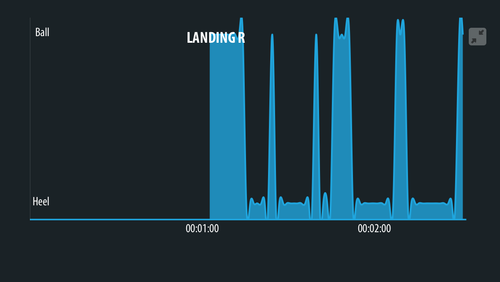 Senoria Hoka Clifton Forefoot Only (app) |
2.3 Forefoot First Hokas
In this test I am landing on my forefoot, but allowing my heel to briefly touch the ground on each foot step. Yet again, you can see good data from the RunScribe system which gives me an overall foot strike index of 10.5. In this test it looks like the Sensoria is working intermittently for the first part of the run and then giving up.
2.4 Rear Strike Endorphin
While running in the rather minimally padded [[[Saucony Endorphin]] you can see that my foot strike is not quite totally on my heel. As the run progresses, the RunScribe system shows that I am passing slightly more midfoot, something that is perhaps not surprising. RunScribe rates my Foot Strike has 2.6, which is still heel striking, but not quite as much as the massively cushioned Hokas. The Sensoria graph bears little resemblance to the RunScribe, and again appears to be more noise than anything else.
2.5 Forefoot Only Endorphin
The story continues in a similar vein when running on my forefoot with the minimally cushioned shoes. Yet again the Sensoria seems to not have any valid data.
2.6 Forefoot First Endorphin
Another failed reading from Sensoria, which interestingly looks a lot like the graph immediately above, though that could be coincidence.
2.7 Rear Strike Glove
The Merrell Vapor Glove is the closest to barefoot running of any shoe I've tried. The soul is so thin that I have to pay close attention to any debris on the road to avoid painful injury. I'd hoped that the lack of cushioning would give the pressure sensors more scope for an accurate reading, but alas the graph looks poor.
2.8 Forefoot Only Glove
With so little padding in the shoe, the pressure sensors in the sock were quite uncomfortable, and I would not want to run like this very far. Yet again the Sensoria bears no resemblance to reality.
2.9 Forefoot First Glove
The final test will be no surprise to anybody who's read this far. I only completed the testing to ensure I'd given Sensoria every opportunity, and for a sense of symmetry in my testing.
2.10 Longer Run
While not a long run by any means, I tried one more time with the Sensoria, comparing it with the RunScribe, Running Dynamics, and MilestonePod. I used the Hoka Tracer with a forefoot only Foot Strike. The Sensoria reported that I was 88% heel striking, with a Ground Contact Time of 337ms and an impact of 1.01 (no units). You can see two views of this run below, one from the web and the other from the mobile app that seems to have less smoothing applied. Yet again, it looks like the pressure sensors are only giving intermittent data.
RunScribe showed a Ground Contact Time of 291ms and a forefoot strike (13.4). You can see the graph below:

MilestonePod showed 100% forefoot, Ground Contact Time of 278ms, while Running Dynamics showed Ground Contact Time of 239ms. The Moov Now reported 7.7g impact, the RunScribe 10.0, and MilestonePod gave the rate of impact as low. However, the impact figures are measured in different ways and in different positions, so it's hard to meaningfully compare them.
